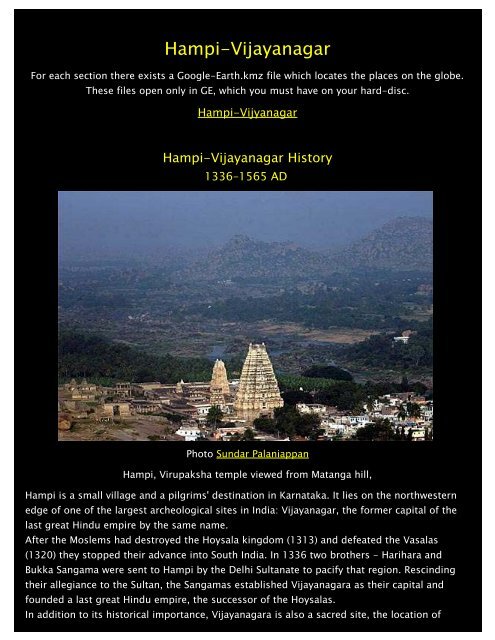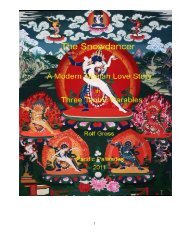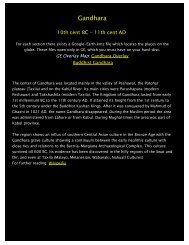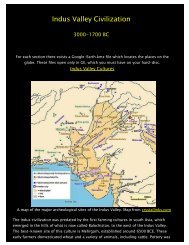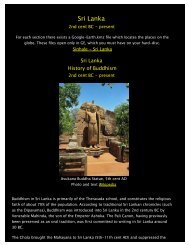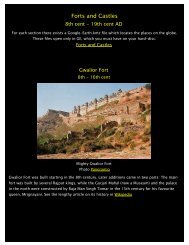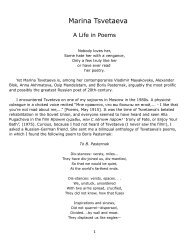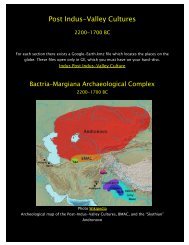Hampi-Vijayanagar - Rolf Gross
Hampi-Vijayanagar - Rolf Gross
Hampi-Vijayanagar - Rolf Gross
You also want an ePaper? Increase the reach of your titles
YUMPU automatically turns print PDFs into web optimized ePapers that Google loves.
<strong>Hampi</strong>-<strong>Vijayanagar</strong><br />
For each section there exists a Google-Earth.kmz file which locates the places on the globe.<br />
These files open only in GE, which you must have on your hard-disc.<br />
<strong>Hampi</strong>-Vijyanagar<br />
<strong>Hampi</strong>-<strong>Vijayanagar</strong> History<br />
1336–1565 AD<br />
Photo Sundar Palaniappan<br />
<strong>Hampi</strong>, Virupaksha temple viewed from Matanga hill,<br />
<strong>Hampi</strong> is a small village and a pilgrims' destination in Karnataka. It lies on the northwestern<br />
edge of one of the largest archeological sites in India: <strong>Vijayanagar</strong>, the former capital of the<br />
last great Hindu empire by the same name.<br />
After the Moslems had destroyed the Hoysala kingdom (1313) and defeated the Vasalas<br />
(1320) they stopped their advance into South India. In 1336 two brothers - Harihara and<br />
Bukka Sangama were sent to <strong>Hampi</strong> by the Delhi Sultanate to pacify that region. Rescinding<br />
their allegiance to the Sultan, the Sangamas established <strong>Vijayanagar</strong>a as their capital and<br />
founded a last great Hindu empire, the successor of the Hoysalas.<br />
In addition to its historical importance, <strong>Vijayanagar</strong>a is also a sacred site, the location of
Hanuman's kingdom. This legendary association, which extends to the identification of<br />
specific places mentioned in the Ramayana, was at the forefront of consciousness of the<br />
people who designed and constructed the city. In 1565 a coalition of Moslem forces defeated<br />
king Ramaraja and sacked the royal capital. The fatally weakened <strong>Vijayanagar</strong> empire<br />
eventually fragmented into a collection of independent Nayaka kingdoms, ruled by their<br />
former governors.<br />
Map of <strong>Hampi</strong><br />
For further reading and the original map go to vijayanagara.org
<strong>Hampi</strong> Hemakuta Hill<br />
1336–1565 AD<br />
View to the northeast from Hemakuta Hill. Virupaksha temple (with tower) in the valley; and<br />
the hills across the Tungabhadra river.<br />
The Small Ganesha Temple (15th century) is located at the base of Hemakuta hill, near the<br />
modern village of <strong>Hampi</strong>. Ganesh is the sole occupant of the temple.<br />
Photos Mary-Ann Campbell
Virupaksha Temple<br />
7th - 16th cent AD<br />
The temple, dedicated to Virupaksha-Pampa, the local river goddess, has an uninterrupted<br />
history from about the 7th century. The sanctuary existed well before the <strong>Vijayanagar</strong>a capital<br />
was located here. Inscriptions referring to Shiva date back to the 9th and 10th centuries. What<br />
started as a small shrine grew into a large complex under the <strong>Vijayanagar</strong>a rulers. Additions<br />
to the temple were made in the later Chalukyan and Hoysala periods, but most of the temple<br />
buildings are attributed to the <strong>Vijayanagar</strong> period. Photo Sundar Palaniappan
A Walk along the Tungabhadra River<br />
7th - 16th cent AD<br />
A pleasant walk along the Tungabhadra river begins at the bazaar and proceeds east a<br />
kilometer or so to the Vitthala temple.<br />
The River at sunset. This is the land of the rishis (sages), famous in the Ramayana as the<br />
monkey kingdom of Sugriva and his general, Hanuman. Photo Panoramio<br />
The King's Balance. The king, sitting in a swing suspended from the balance, would be<br />
ceremonially weighed against heaps of precious objects, which he would then distribute as<br />
gifts. Photo hobotraveler.com
Ranganatha Temple. This small temple along the path is dedicated to Ranganath, the<br />
reclining form of Vishnu. Photo art-and-archaeology.com<br />
Ritual Tank<br />
14th cent AD<br />
The tank measures 67m x 22m (223ft x 73ft), about 2/3 the length of an American football<br />
field. Water was brought in by aqueduct for special events (such as boat fights), then drained<br />
out afterwards. The view faces west; a small group of people on the north side provides a<br />
sense of scale. Photo and Text from art-and-architecture.com
Great Mahanavami Platform<br />
15th cent AD<br />
Photo Mary-Ann Campbell<br />
According to a 16th-century Portuguese visitor, King Krishnadevaraya would ascend the<br />
platform during the Mahanavami festival, where he would perform worship and view the<br />
parades of animals, musicians and dancers, mock battles, and fireworks below.<br />
Photo from travelblog.org<br />
The two lower courses, which were built during the first phase of construction, are inscribed<br />
in parallel bands with scenes of courtly life, including hunting scenes and processions of<br />
animals, soldiers, musicians, and dancers.
Lotus Mahal<br />
15th cent AD<br />
The building is a fascinating fusion of Indian and Islamic architecture. Its arches are Islamic,<br />
but its platform and towers are purely Indian. Photo Sundar Palaniappan<br />
Krishna Temple<br />
1516 AD<br />
This partly collapsed temple, located south of Hemakuta Hill, was built to celebrate a military<br />
victory of King Krishnadevaraya. Photo Sundar Palaniappan
Narasimha Monolith<br />
1528 AD<br />
The man-lion incarnation of Vishnu is seated beneath a serpent canopy in a yoga posture.<br />
The band around his legs helps him to hold the position for long periods of time.<br />
This much-photographed statue has been extensively restored. It was commissioned in 1528<br />
by king Krishnadevaraya, stands 6.7m (21ft) high, and is located just south of the Krishna<br />
temple. Photo Mary-Ann Campbell
Vitthala Temple<br />
1554 AD<br />
Vitthala Temple, The 16th century temple is dedicated to Vitthala, a form of Vishnu.<br />
Photo Panoramio<br />
East end of the temple complex, looking west. From front to back we see a square platform,<br />
the east face (rear) of a Garuda shrine which faces the temple, and the star-shaped<br />
mahamandapa (great pillared hall, 1554) of the temple itself.<br />
Photos and text Mary-Ann Campbell<br />
The Kalyana mandapa is an open pavilion. Its interior, surrounded by impressive columns,<br />
contains a platform in the center (very slightly raised circle, inside a square) for the
performance of sacred dances. connected with the wedding ceremony of the God and his<br />
Shakti. The building in the background is the mandapa of the main temple.<br />
View of the chariot.<br />
Photo Sundar Palaniappan<br />
Ramachandra Temple<br />
1554 AD<br />
The Ramachandra temple, also called Hazara Rama ("One thousand Ramas"), was built in the<br />
1420s (with later additions) as a royal chapel dedicated to the cult of Rama. The temple is the<br />
hub of all the eastern roads that lead into the royal center. Its sculptural program centers on<br />
the Ramayana, with friezes from that epic being carried out on the temple walls. Photo art
and archeology<br />
"Elephant Stables"<br />
16th cent AD<br />
The original use of this building is not known. Beneath each dome is a single large chamber<br />
with a painted ceiling. Photo by Mary-Ann Campbell<br />
Thiruvengalanatha-Achutharaya Temple<br />
1534 AD<br />
Achutharaya bazzar and Pushkarni
Thiruvengalanatha temple which is also known as Achutharaya temple<br />
Photos Sundar Palaniappan


